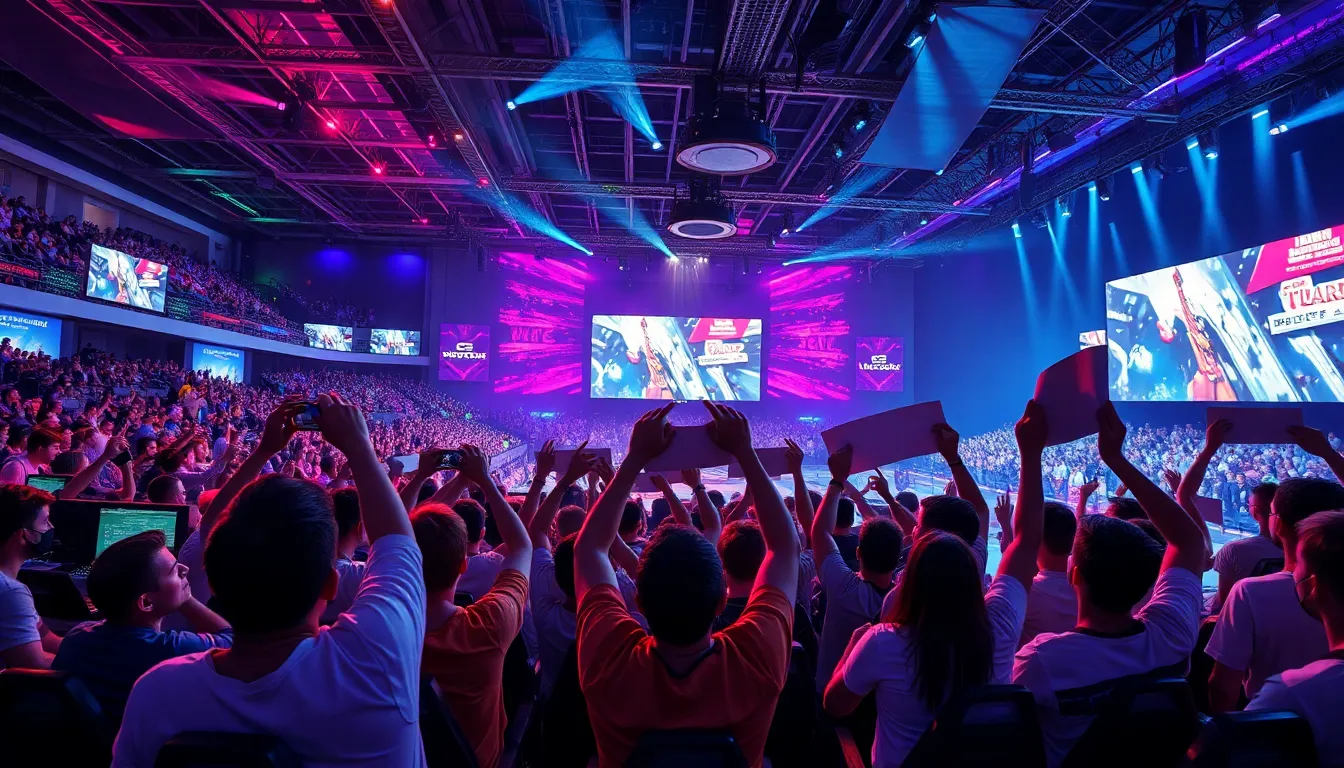In the fast-paced world of esports, the arena isn’t just a venue; it’s a battleground where legends are born and dreams are shattered. Imagine a space buzzing with energy, where fans cheer louder than a jet engine and players are fueled by adrenaline and energy drinks. The design of these arenas plays a crucial role in creating that electric atmosphere, blending cutting-edge technology with fan-friendly features.
Table of Contents
ToggleOverview of Esports Arena Design
Esports arena design focuses on creating immersive environments that engage players and audiences alike. Key elements include seating arrangements, acronyms for arena specifications, and advanced sound systems. Effective seating ensures optimal viewing angles, accommodating large crowds while enhancing the spectator experience.
Lighting plays a significant role in arena design, creating dramatic effects that amplify on-screen action. Screens and displays offer high-definition visuals, allowing fans to follow the game closely from various angles. Incorporating large LED screens enhances visibility and creates an electrifying atmosphere.
Sound systems contribute to the overall ambiance by delivering clear audio while building excitement. Live commentary broadcasts through well-placed speakers, providing fans with an engaging information experience. The integration of technology remains vital, as arenas often utilize augmented reality components that deliver enhanced interactions for fans.
Accessibility ranks high among design priorities, ensuring all fans can enjoy the action comfortably. Representatives in the field advocate for wider aisles, accessible restrooms, and dedicated seating areas. Clear signage directs attendees to different sections within the arena, fostering a smoother experience.
Community spaces are also essential in esports arenas, encouraging camaraderie among fans. Design plans often include lounges, gaming stations, and food vendors, creating a vibrant social scene. These areas allow fans to gather, share experiences, and celebrate moments together.
Esports arena design focuses on immersive experiences through seating, lighting, sound, accessibility, and community engagement. The combination of these elements contributes to a unique environment where spectators and players thrive.
Key Elements of Esports Arena Design

Esports arena design relies on various key elements that enhance the overall experience for both players and fans. The following areas focus on crucial aspects of effective arena design.
Structural Considerations
Structures must prioritize maximum visibility and comfort. Designing tiered seating arrangements allows unobstructed views of the stage. Ensuring spacious walkways facilitates easy movement throughout the arena. Incorporating flexible spaces supports different event formats, accommodating both casual tournaments and large-scale competitions. Robust materials promote durability while maintaining aesthetic appeal.
Acoustic Design
Acoustic design significantly impacts the audience’s experience. Utilizing sound-absorbing materials minimizes unwanted echoes and creates a focused auditory environment. Positioning high-quality speakers throughout the arena ensures clear sound transmission. Integrating designated areas for live commentary enhances engagement and excitement. Employing advanced technology allows for seamless audio mixing, delivering crisp sound and immersive experiences during events.
Lighting and Visuals
Lighting and visuals play vital roles in creating an electrifying atmosphere. Dynamic LED lighting enhances the gaming environment, highlighting key moments during competitions. Strategically placed projectors showcase stunning graphics on large screens, ensuring all attendees can follow the action. Emphasizing a color palette that reflects the brand of the event enriches the overall aesthetic. Effective collaboration between lighting and visual effects elevates the spectator experience, driving emotional engagement and excitement.
Technology Integration in Esports Arenas
Technology significantly enhances the esports arena experience, illuminating every match with precision.
Gaming Equipment
Modern arenas feature state-of-the-art gaming equipment, ensuring players have access to the latest hardware. High-performance gaming PCs, equipped with the latest graphics cards and processors, deliver seamless gameplay. Ergonomic gaming chairs promote comfort during long matches, encouraging peak performance. Competitive gaming requires fast, reliable internet connections, so dedicated high-speed networks support uninterrupted play. Additionally, peripherals like customizable keyboards and mice enhance players’ capabilities, allowing for quick reflexes and strategic advantages.
Streaming and Broadcasting Facilities
Advanced streaming and broadcasting facilities play a crucial role in esports arenas. Multiple camera setups capture every angle of gameplay, providing viewers with dynamic perspectives. High-definition screens allow audiences to see intricate details, whether in-person or online. Dedicated broadcasting booths house commentators and analysts, delivering engaging content to fans globally. Furthermore, integration with online streaming platforms enables real-time interaction between players and fans, fostering community engagement and expanding audience reach.
Audience Experience and Engagement
Engaging the audience is essential in esports arena design. Thoughtful design elements create a memorable experience for both fans and players.
Seating Arrangements
Optimal seating arrangements enhance visibility and comfort. Tiered seating ensures that everyone enjoys a clear view of the action. Width and spacing between seats prevent crowding, allowing fans to move freely. Group seating areas foster social interaction, inviting friends to enjoy the event together. Accessible seating options cater to fans with disabilities, ensuring inclusivity for all. Clear sightlines paired with close proximity to the stage keep the atmosphere electric.
Interactive Features
Interactive features elevate engagement levels among fans. Touchscreen kiosks provide information on schedules, player stats, and real-time updates. Augmented reality experiences immerse viewers, placing them in the game environment. Fan zones invite participation, offering games, merchandise, and meet-and-greets with players. High-speed Wi-Fi access supports social media interaction, allowing fans to share their experiences instantly. Keyboards and other peripherals in designated areas encourage hands-on participation, drawing in gamers and non-gamers alike.
Sustainability in Esports Arena Design
Sustainability plays a vital role in the design of esports arenas. Designers prioritize eco-friendly materials and energy-efficient technologies to minimize the environmental impact. They incorporate renewable energy sources, such as solar panels, which significantly reduce reliance on fossil fuels.
Water conservation measures contribute to sustainable practices. Low-flow plumbing fixtures and rainwater harvesting systems help manage water usage effectively. Integrating green roofs adds aesthetic value while providing insulation and supporting biodiversity.
Transportation considerations enhance sustainability in arena design. Accessible public transport links and bike racks encourage eco-friendly travel options, reducing the carbon footprint associated with arena attendance. Incorporating electric vehicle charging stations promotes the use of electric cars among visitors.
Waste management strategies also play a key role. Implementing recycling and composting programs within the arena helps divert waste from landfills, fostering a culture of sustainability among attendees. Collecting data on waste generation improves these initiatives over time.
Indoor environmental quality is critical for player and spectator health. Utilizing non-toxic materials and ensuring proper ventilation creates a safe atmosphere. Natural light enhances the experience, breaking up artificial lighting while promoting well-being.
Community engagement in sustainability initiatives strengthens the connection between the arena and its surroundings. Hosting local sustainability events and providing educational resources amplify the impact. Engaging fans in eco-friendly practices cultivates long-lasting change beyond the venue.
Overall, the integration of sustainability within esports arena design embodies a commitment to the environment. As awareness of ecological issues grows, these design strategies not only enhance the experience but also contribute to a sustainable future for the esports industry.
Esports arena design plays a pivotal role in shaping the future of competitive gaming. By focusing on immersive environments and advanced technology, designers create spaces that captivate both players and fans. The integration of thoughtful features enhances the overall experience, ensuring comfort and engagement.
Sustainability also emerges as a critical component, reflecting a commitment to the environment while fostering community connections. As esports continues to grow, the importance of innovative arena design will only increase, driving the industry toward exciting new possibilities. Ultimately, these arenas serve not just as venues but as vibrant hubs for gaming culture and community interaction.



